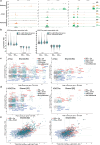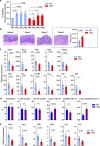Mechanisms of epigenomic and functional convergence between glucocorticoid- and IL4-driven macrophage programming
- PMID: 39424780
- PMCID: PMC11489752
- DOI: 10.1038/s41467-024-52942-x
Mechanisms of epigenomic and functional convergence between glucocorticoid- and IL4-driven macrophage programming
Abstract
Macrophages adopt distinct phenotypes in response to environmental cues, with type-2 cytokine interleukin-4 promoting a tissue-repair homeostatic state (M2IL4). Glucocorticoids (GC), widely used anti-inflammatory therapeutics, reportedly impart a similar phenotype (M2GC), but how such disparate pathways may functionally converge is unknown. We show using integrative functional genomics that M2IL4 and M2GC transcriptomes share a striking overlap mirrored by a shift in chromatin landscape in both common and signal-specific gene subsets. This core homeostatic program is enacted by transcriptional effectors KLF4 and the glucocorticoid receptor, whose genome-wide occupancy and actions are integrated in a stimulus-specific manner by the nuclear receptor cofactor GRIP1. Indeed, many of the M2IL4:M2GC-shared transcriptomic changes were GRIP1-dependent. Consistently, GRIP1 loss attenuated phagocytic activity of both populations in vitro and macrophage tissue-repair properties in the murine colitis model in vivo. These findings provide a mechanistic framework for homeostatic macrophage programming by distinct signals, to better inform anti-inflammatory drug design.
© 2024. The Author(s).
Conflict of interest statement
The authors declare no competing interests.
Figures






Update of
-
Mechanisms of Epigenomic and Functional Convergence Between Glucocorticoid- and IL4-Driven Macrophage Programming.bioRxiv [Preprint]. 2024 Feb 18:2024.02.16.580560. doi: 10.1101/2024.02.16.580560. bioRxiv. 2024. Update in: Nat Commun. 2024 Oct 18;15(1):9000. doi: 10.1038/s41467-024-52942-x. PMID: 38405750 Free PMC article. Updated. Preprint.
References
Publication types
MeSH terms
Substances
Associated data
- Actions
- Actions
- Actions
- Actions
Grants and funding
- NIH R01DK099087/U.S. Department of Health & Human Services | National Institutes of Health (NIH)
- R01 AI148129/AI/NIAID NIH HHS/United States
- NIH R01AI148129/U.S. Department of Health & Human Services | National Institutes of Health (NIH)
- R01 AI148416/AI/NIAID NIH HHS/United States
- F31 HL152706/HL/NHLBI NIH HHS/United States
LinkOut - more resources
Full Text Sources
Medical
Molecular Biology Databases
Miscellaneous

